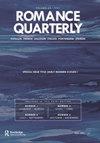不安定的殖民主义:19世纪全球西班牙裔世界的性别与种族
IF 0.2
3区 文学
0 LITERATURE, ROMANCE
引用次数: 0
摘要
令人不安的殖民主义是西班牙后殖民研究书目中一个受欢迎的补充,它专注于性别在一个摇摇欲坠的帝国的殖民话语中经常被忽视的角色。这本书的重点是19世纪漫长的文学和文化作品,在此期间,西班牙在失去美洲殖民地和向非洲扩张的情况下,努力将自己定位为一个国家。这个时代充满了发现被遗忘的女性声音的机会,这也是许多章节的重点。分为“殖民主义与妇女移民”三个部分;“种族、表现和殖民意识形态”;“文学和政治辩论中的性别和殖民主义”——《令人不安的殖民主义》通过种族和性别交叉的棱镜重新定义了西班牙殖民主义的遗产。Benita Sampedro Vizcaya的文章“气象的殖民政治”揭示了Isabel和Manuela Urquiola在绘制几内亚湾时的科学贡献。伊莎贝尔的丈夫曼努埃尔·伊拉迪尔(Manuel Iradier)被誉为伟大的探险家,佛朗哥政权还向他颁发了纪念其百年诞辰的邮票,而在1874年至1877年期间,正是他的妻子和嫂子收集了数据,为中非的探索和定居提供了便利。他们从历史上的抹去与英国的玛丽·亨丽埃塔·金斯利所获得的荣誉形成鲜明对比。在这一组的第二章“伊娃·卡纳尔和西班牙裔的性别”中,丽莎·苏威罗(Lisa Surwillo)将《古巴之旅》(1916)作为新帝国主义西班牙裔的产物进行了有力的分析,卡纳尔在面对美国占领时捍卫西班牙在古巴文化定义中的中心地位。卡纳尔获得政府资助的渠道有限,这使她能够在创作反对美国文化入侵古巴的作品时,声称自己完全独立于监管之外。土屋明子研究了“尤金尼奥·弗洛雷斯的《白色的图画》和尤金尼奥·洛佩斯·贝戈的《进口的画》中对白人奴隶制的表现”。这两部小说都是在1860年至1930年间欧洲女性性交易的背景下进行研究的。在“激进自然主义”的保护伞下,两位作者都把妓女作为欧洲社会的碎片来研究,以一种将她们患病的身体作为表达对性别、种族杂质和帝国丧失的文化焦虑的出口。第二部分侧重于表演,从安娜·马特奥斯的《在福斯蒂娜·S·阿兹·德·梅尔加的《悲惨世界》(1862-63)中被称为“外鬼”的黑人妇女开始,研究了这位伊莎贝尔作家的废奴主义和女权主义关切。通过她在马德里的黑脸出现,主人公的行为突出了妇女和奴隶的共同困境,加上她作为黑人妇女的姿态比她阶级的白人妇女更少的社会约束,这增加了复杂性。更有趣的是,马特奥斯研究了慈善事业在赋予女性、甚至有色人种女性更大的社会能力性方面的作用。Mar Soria在她的章节中继续关注黑脸在g enero chico中使用这种装置将黑人身体商品化以取悦西班牙观众他们通过看到殖民主义在舞台上的动态表现而感到自己是帝国的成员。最后一部分以茱莉亚·张(Julia Chang)的《变得无用:19世纪西班牙的男子气概、健全的身体和帝国》(Becoming Useless: Masculinity, able - bodies, and Empire in 19世纪的西班牙》(Becoming无用)开始,该书考察了军队在定义男子气概时所扮演的角色,因为士兵的身体成为了帝国可见的象征。因此,殖民主义创造了一个生物政治战场,在这个战场上,半岛和殖民地的主体都被性别化了,并根据它们对帝国事业的效用进行了分类。努里亚·神论《浪漫》研究《季刊》2022年第69卷第1期。4, 230 - 231本文章由计算机程序翻译,如有差异,请以英文原文为准。
Unsettling Colonialism: Gender and Race in the Nineteenth-Century Global Hispanic World
Unsettling Colonialism is a welcome addition to the growing bibliography on Hispanic postcolonial studies through its concentration on the often-neglected role that gender played in the colonial discourse of a crumbling empire. The book’s focus is on the literary and cultural productions of the long nineteenth-century, a period during which Spain struggled to define itself as a nation in the face of the loss of its American colonies and its expansion into Africa. The era is rich in opportunities to discover forgotten female voices, a focus of many of the chapters. Divided into three sections—“Colonialism and Women’s Migrations”; “Race, Performance, and Colonial Ideologies”; “Gender and Colonialism in Literary and Political Debates”—Unsettling Colonialism reconceptualizes the legacy of Spanish colonialism through the prism of the intersections of race and gender. Benita Sampedro Vizcaya’s essay, “The Colonial Politics of Meteorology,” uncovers the scientific contributions of Isabel and Manuela Urquiola while charting the Gulf of Guinea. Whereas Isabel’s husband, Manuel Iradier, was heralded as a great explorer, honored by the Franco regime with stamps commemorating the centenary of his birth, it was his wife and sister-in-law who between 1874 and 1877 gathered the data that facilitated the exploration and settlement of Central Africa. Their erasure from history stands in sharp contrast to the honors garnered by the English Mary Henrietta Kingsley. In the second chapter of this grouping, “Eva Canal and the Gender of Hispanism,” Lisa Surwillo cogently analyzes Lo que vi en Cuba, a trav es de la isla (1916) as a product of neoimperial Hispanism with Canal’s zeal to defend Spain’s centrality to the definition of Cuban culture in the face of U.S. occupation. Canal’s limited access to government funding allowed her to claim full independence from oversight as she produced counternarratives to the incursion of U.S. culture in Cuba. Akiko Tsuchiya studies the “Representations of White Slavery in Eugenio Flores’s Trata de blancas and Eugenio L opez Bago’s Carne importada.” Both novels are studied within the context of the sex trafficking of European women between 1860 and 1930. Under the umbrella of “radical naturalism,” both authors study prostitutes as the detritus of European society in a way that posits their diseased body as an outlet for expressing cultural anxieties about gender, racial impurities, and the loss of empire. The second section, focusing on performance, begins with Ana Mateos’s “A Black Woman Called Blanca la extranjera in Faustina S aez de Melgar’s Los miserables (1862–63),” a study of the abolitionist and feminist concerns of the Isabelline writer. Through her appearance in Madrid wearing blackface, the protagonist’s actions highlight the shared plight of women and slaves, with the added complexity that in her pose as a black woman she has less social constrictions than a white woman of her class. Of added interest is Mateos’s study of the role of philanthropy in granting women, even women of color, greater agency in society. Mar Soria continues the focus on blackface in her chapter on the use of this device in the g enero chico to commodify the black body for the amusement of Spanish audiences who felt themselves as members of an empire by seeing the dynamics of colonialism played out on the stage. The final section begins with Julia Chang’s “Becoming Useless: Masculinity, Able-Bodiedness, and Empire in Nineteenth-Century Spain,” which examines the role of the military in defining masculinity as the bodies of soldiers became the visible emblems of empire. Thus, colonialism creates a biopolitical battleground upon which both peninsular as well as colonial bodies are gendered and classified in terms of their utility to the imperial enterprise. Nuria God on’s study of La ROMANCE QUARTERLY 2022, VOL. 69, NO. 4, 230–231
求助全文
通过发布文献求助,成功后即可免费获取论文全文。
去求助
来源期刊

ROMANCE QUARTERLY
LITERATURE, ROMANCE-
CiteScore
0.30
自引率
50.00%
发文量
18
期刊介绍:
Lorca and Baudelaire, Chrétien de Troyes and Borges. The articles in Romance Quarterly provide insight into classic and contemporary works of literature originating in the Romance languages. The journal publishes historical and interpretative articles primarily on French and Spanish literature but also on Catalan, Italian, Portuguese, and Brazilian literature. RQ contains critical essays and book reviews, mostly in English but also in Romance languages, by scholars from universities all over the world. Romance Quarterly belongs in every department and library of Romance languages.
 求助内容:
求助内容: 应助结果提醒方式:
应助结果提醒方式:


